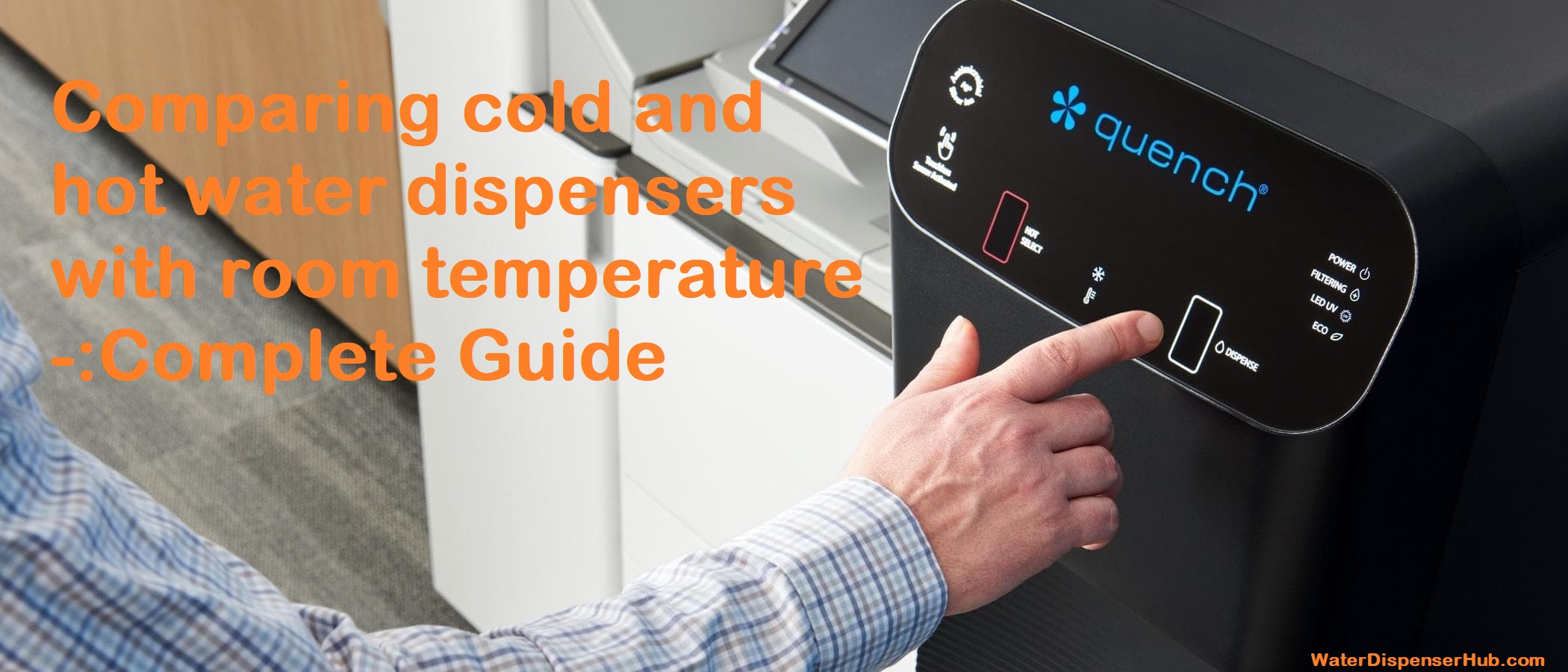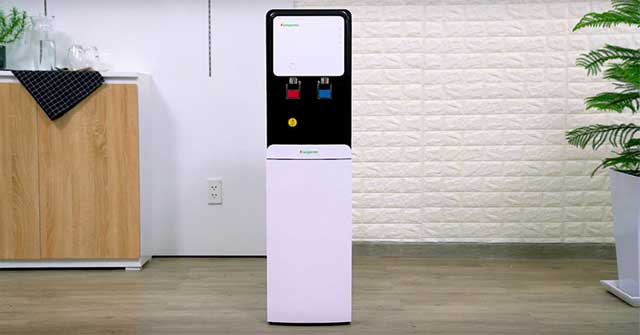You deserve to have clean, cold or hot water on demand. But do you know which water dispenser is ideal for you?
Find out in this comprehensive guide which will help you compare cold and hot water dispensers with room temperature. Make a better decision today.
Welcome to our guide on comparing hot, cold, and room temperature water dispensers. This guide will provide an overview of the advantages and disadvantages of each type of water dispenser. After reading this guide, you will have a better understanding of which type of water dispenser is best for you.
We will discuss how to choose the right model, compare different types of the units, and assess which one provides more value for money overall. Finally, we will consider other important factors such as energy efficiency, safety features, and warranty terms when selecting the right water dispenser. So let’s get started!

Definition of cold and hot water dispensers with room temperature
Cold and hot water dispensers with room temperature refer to systems that can dispense water heated or cooled to a temperature between 40°F and 180°F, as well as room-temperature water. These units are typically freestanding and come in both standard and countertop sizes. They offer convenience, affordability, safety, and energy efficiency compared to traditional heating methods or individual hot/cold taps.
Cold water dispensers provide safe drinking water free from lead or other contaminants with filtered water technology. Many of these models can also reduce lime scale buildup or filter out chlorine or odors from tap water. Cold-water dispensers vary in size and offer lower capacities for small spaces like apartments or individual offices, as well as larger model for commercial use or large homes/apartments.
Hot-water dispensers provide containers of fresh boiling hot beverages such as tea at an optimal drinking temperature without the wait time of a kettle. Hot-water dispensed technology is becoming increasingly more common in offices, schools and public settings due to its convenience and safety features such as childproof lids that prevent accidental burning. In addition to the varied storage options available depending on space requirements most vendors also have different temperature settings so you have full control over the temperature provided regardless of place settings.
Benefits of using a water dispenser
Water dispensers offer convenience, safety and cost savings by providing multiple temperatures of water at your fingertips. Some water dispensers come with a hot and cold option, while others also provide room temperature or even sparkling cold water.
Hot water dispensers often offer a range of temperatures with safety precautions in place to prevent accidental scalding. They are great for quickly making beverages like tea or cocoa, soups, cereals and more without having to wait for the stove or microwave for a long time. Plus, many people find hot drinking water easier to digest than cold as it helps break down food more easily in the stomach.
Cold water dispensers are great for keeping drinks like lemonade or iced tea cold, hydrated through exercise, and providing quick relief from the heat during hot summers days. Furthermore, some research suggests that cold water may allow the body to absorb nutrients more quickly – allowing you to feel nourished faster after eating a meal.
Room temperature is another options offered by some units which can help save money by reducing electricity costs if your home already has its own source of temperature-regulated air such as an air conditioner or central heating system – no need to use energy supply additional heating elements in your unit! Additionally room temperature can also be beneficial when filling up large containers with boiling liquid (such as when making pizza dough) as it will not immediately cause it too start cooking before you have had time mix together other ingredients!
Convenience
Water dispensers offer an easy way to enjoy filtered, purified drinking water with convenience and portability. Consumers can choose from a variety of options that meet their requirements, including cold water dispense, hot water dispense and room temperature.
Cold and hot water dispensers are the most common type of equipment used in both home and commercial applications. Cold dispensers provide chilled drinking water for refreshment or use cold/hot combination models when needing boiling temperatures as well. Room temperature models are useful when needing neutral temperatures for brewing beverages such as coffee or tea without having to worry about monitoring the temperature of boiling water.
Cold water dispensers provide a chilled stream of filtered drinking water ideal for hydration during sports activities, making smoothies or other daily beverages. Hot reliable and efficient dispensers are versatile appliances that ensure the right temperature for preparing tea and coffee, killing germs when making soup or reconstituting powdered foods quickly with steamy hot temperatures. Room temperature models are efficient devices perfect to prepare drinks where boiling pans aren’t desired or excessive heat isn’t necessary according to certain recipes like tea blending or lemonade mixing that require lukewarm rather than scorching heat levels coming from kettles and boilers for example.
All Water Dispensers present several advantages like offering great tasting clean drinkable substances, faster delivery than a traditional boiling units, more compact design providing more counter space in homes/offices, requiring no plumbing works saving installation costs on set up times as well offering different type of faucets options tailored depending on each user’s needs like battery operated push buttons taps which add convenience factor to these devices compared with classic handle knobs found on many kitchen sinks these days.
Cost-effectiveness
Cost-effectiveness is a major consideration when deciding between a hot and cold water dispenser. Cold water dispensers may use more electricity than room temperature models, but their greater convenience can make up for this cost. In the long run, hot water dispensers might be more cost effective in the long run. Hot water is more in demand and costs less to produce than colder temperatures, so you can save money on your energy bills with these types of units.
Additionally, since hot water is already pre-heated you don’t have to wait for it to get cold like you do with a cold dispenser. Preparing meals and drinks, such as tea or coffee, is much quicker when you’re using a hot water dispenser.
On the other hand, if usage is low then room temperature or cold water dispensers might be the better choice because they use less electricity over time and are usually cheaper up front.
Health benefits
The health benefits of cold and hot drinking water dispensers are plentiful. While cold and hot water dispensers both have the same essential benefit of providing filtered tap water, each has its own set of nutritional benefits.
Cold drinking water aids digestion, reduces cravings, helps to detoxify the body, can help improve skin tone and complexion, maintains healthy fluid balance and can also help with kidney problems. Hot drinking water helps digestion as well, is known to have certain antiviral properties and may even help reduce anxiety.
Room temperature drinking water from a filtered dispenser is great for hydration without any of the additional health benefits associated with either cold or hot water.
III.Factors to consider when choosing a water dispenser
When considering the different types of water dispensers available, there are several factors to take into account, including space availability, cost, cleaning convenience, and setup process. Depending on the type of dispenser you’re thinking of purchasing, installation may be required. If you’re an avid “DIY-er”, installation may not be a problem but it is always important to read through the installation directions carefully in order to ensure that the product is used properly and safely.
When looking at cold and hot water dispensers with room temperature options, here are some questions you should ask:
- How much space do I have?
- Do I prefer a countertop or freestanding option?
- Will I need to run any plumbing or electrical work?
- Do I need a product with built-in filtration capability?
- Do I want two taps for both hot and cold water or a single tap for all three temperatures?
- How much am I willing to invest in this product?
Water source and quality
The source and quality of water used for a cold or hot water dispenser is key for quality assurance. Generally, tap water should be avoided as it often has an unpleasant taste, with chlorine and other minerals present that may adversely affect the flavor of beverages like coffee. The best option is to install a reverse osmosis filtration system connected directly to the water dispenser, allowing for clean-tasting water.
It’s also important to consider whether you will need both hot and cold temperatures available simultaneously. Systems that provide both hot and cold from the same tap are more convenient but do tend to be more expensive due to their increased capacity requirements. If hot and cold are not required at the same time, consider buying separate systems that offer one temperature each—this can often save you money in both installation costs and ongoing energy bills.
Available space
When shopping for a water dispenser, it’s important to first consider how much space you’re willing to dedicate for your new appliance and the surrounding counter or workspace.
Cold and hot water dispensers come in many sizes and styles, so when possible bring measurements of the available space you have designated. With the right measurements in hand you will be able to more easily find a solution that meets both your taste preferences and free counter-space size requirements.

Budget
When choosing between a cold and hot water dispenser, the most important factor to consider is budget. Hot water dispensers tend to be pricier than cold ones, and some models come with the additional investment of a built-in filter system. Cold water dispensers are usually less expensive due to their simpler design. The individual components may also cost less, so shop around for the best deals.
To keep costs down when investing in either style of machine consider using an instant tankless unit, as these eliminate the costs of a storage tank for hot and cold water.
Brand and warranty
When selecting between hot, cold and room temperature water dispensers, it is important to consider the reputation of the brand. Quality machines from reputable companies will offer reliable and consistent performance over extended amounts of time with minimal maintenance required. Warranties and service contracts should also be taken into account when making a purchase in order to ensure that the equipment is properly maintained and supported.
Many companies that manufacture water dispensers offer warranties, usually lasting one year or longer depending on the product. This can provide peace of mind knowing that repairs or breakdowns will be covered by the manufacturer or service provider for an extended amount of time following installation. Furthermore, some brands offer additional service contracts which offer coverage for parts and labour up to a specific limit.
Another major factor to consider when choosing a water dispenser is customer support availability in case you experience any difficulties with your machine. Excellent customer service teams will be available by phone and/or email in order to answer queries or provide further information as quickly as possible – this can prove especially helpful if you’re facing technical issues with your product that require specialised knowledge and expertise on the matter.
Conclusion
In conclusion, both hot and cold water dispensers offer advantages and drawbacks, depending on one’s individual needs. For those who need hot water quickly at any time of the day – such as for coffee or tea, a hot water dispenser may be the most suitable option. On the other hand, those who need a more affordable and energy-efficient choice may opt for cold water dispensers.
Additionally, if you are looking for a simple and reliable source of room temperature water at all times – such as for drinking or cooking – then a room temperature or ambient temperature water dispenser can serve as the ideal solution. Ultimately, the decision between hot and cold water comes down to personal preference and budget concerns.
All in all, both types of dispensers are cost-effective solutions that make life simpler.
FAQ’s
Which is the best hot and cold water dispenser?
There are several good hot and cold water dispensers available in the market, such as Primo, Avalon, and Whirlpool. The best one for you will depend on your specific needs and preferences.
Are hot and cold water dispensers worth it?
If you frequently need hot and cold water and don’t want to use a traditional water cooler, then a hot and cold water dispenser can be a convenient and efficient option. However, they do require maintenance and can be more expensive than a simple water cooler.
Which water dispenser is best?
The best water dispenser for you will depend on your specific needs and preferences. Some good options include countertop or freestanding models, bottom-loading dispensers, and hot and cold water dispensers.
Are hot water dispensers worth it?
Hot water dispensers can be worth it if you frequently use hot water for tea, coffee, or other purposes. They can save time and energy compared to heating water on a stove or in a microwave.
How do I choose a water dispenser for my house?
Consider factors such as the size and layout of your home, the number of people who will be using the dispenser, your budget, and the features you need (such as hot and cold water, filtration, or bottom-loading design).
Why buy a hot water dispenser?
A hot water dispenser can be a convenient and efficient way to quickly heat water for tea, coffee, or other purposes. It can also save energy compared to heating water on a stove or in a microwave.
Do water dispensers use a lot of electricity?
Water dispensers vary in their energy usage, but most are designed to be energy-efficient. Hot water dispensers will use more electricity than cold-only models, so it’s important to choose a model with good insulation and an energy-saving mode.
Which brand of hot water dispenser is best?
Some popular brands of hot water dispensers include InSinkErator, Zojirushi, and Breville. The best brand for you will depend on your specific needs and preferences.
Which company makes the best hot and cold water bottle?
Some good companies that make hot and cold water bottles include Hydro Flask, CamelBak, and Yeti. The best one for you will depend on your specific needs and preferences.
What should I look for in a hot water dispenser?
When choosing a hot water dispenser, consider factors such as the capacity of the tank, the temperature settings, the speed of heating, the energy efficiency, and the durability of the unit.
See more-
- Best bottleless water dispenser 2023
- Best water dispenser 2023
- Best water dispenser with ice maker 2023
- Best self cleaning water dispenser 2023
- Best cold and hot water dispenser 2023

Robert Carlson is the CEO of waterdispenserhub.com and informative website, and a respected author in the dispenser industry. With years of experience and a passion for his work, Robert has become a trusted source of information for consumers and businesses alike. His dedication to excellence and commitment to providing unbiased and independent reviews have earned him a loyal following of readers who trust his expertise and insights. Robert is a true industry expert and a leader in the dispenser industry, and his work has been recognized by his peers and featured in various publications and media outlets.

